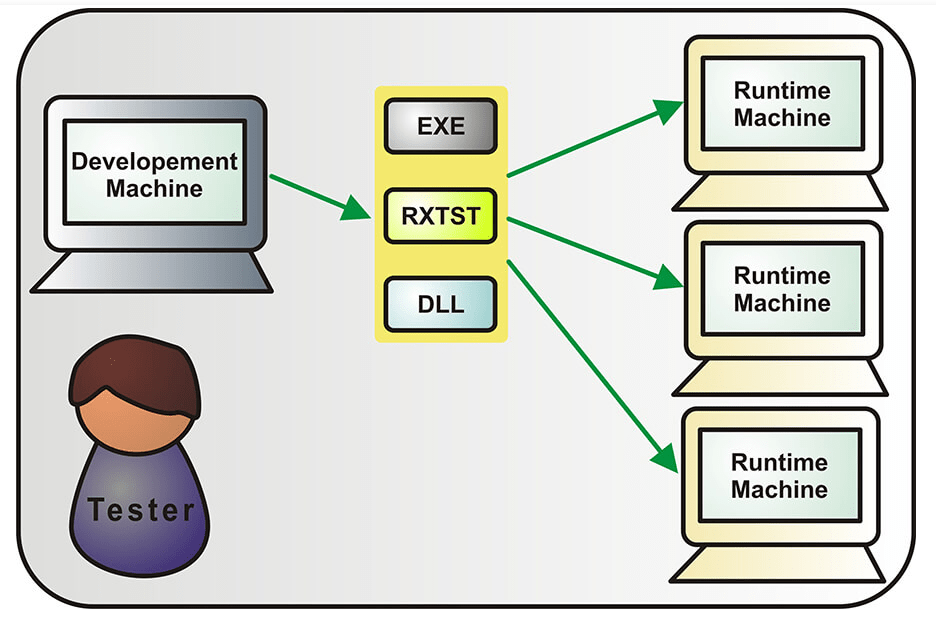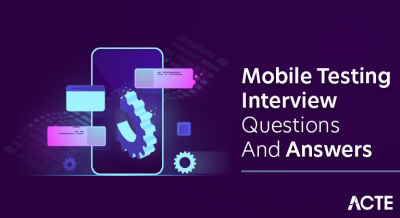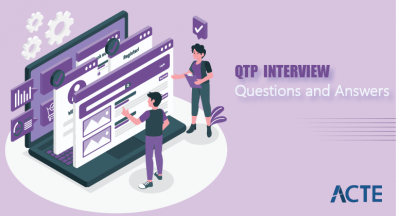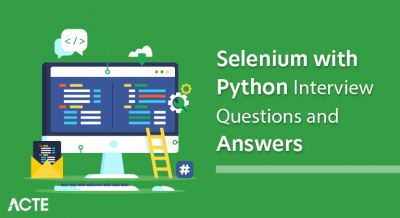
Ranorex is a powerful test automation tool used to create and execute automated tests for desktop, web, and mobile applications. It offers a user-friendly interface and robust features for recording, scripting, and debugging tests. With Ranorex, testers can efficiently automate repetitive tasks, verify application functionality, and ensure software quality across various platforms and environments. Its ability to integrate with CI/CD systems enhances test automation workflows. Ranorex simplifies test creation and maintenance, accelerating the testing process and enabling teams to deliver high-quality software faster.
1. Ranorex: What is it?
Ans:
Ranorex is a GUI testing tool for automating actions on desktop, web, and mobile apps. It features an intuitive interface for test creation and execution. Ranorex supports multiple programming languages and enhances testing efficiency. It’s a comprehensive solution for automated software testing, improving accuracy and coverage. Testers can rely on Ranorex to reduce manual effort and enhance testing productivity.
2. Enumerate the attributes of Ranorex.
Ans:
- Ranorex offers robust GUI recognition and a powerful test automation IDE.
- It supports data-driven testing, provides built-in reporting, and supports cross-platform testing.
- Integration with various CI/CD tools is seamless, enhancing automation workflows.
- Ranorex facilitates efficient test creation and maintenance, improving test coverage and accuracy.
- With its user-friendly interface and advanced features, Ranorex stands as a comprehensive test automation solution.
3. What benefits does Ranorex offer?
Ans:
- Ranorex simplifies test creation and maintenance, enhancing testing efficiency and accuracy.
- It offers detailed reporting for comprehensive test analysis and supports parallel test execution for faster results.
- With support for multiple programming languages, Ranorex accommodates diverse testing needs.
- Integration with other testing tools and systems is seamless, improving overall automation workflows.
4. How does Ranorex identify the UI element?
Ans:
Ranorex identifies UI elements using a combination of RanoreXPath and attribute values. Its recognition algorithm locates elements accurately, capturing unique identifiers during recording. Testers can define custom element locators for precise identification, ensuring reliable automation. Visual validation in Ranorex verifies element identification for increased accuracy.
5. How to execute the project on runtime machines in Ranorex?
Ans:
To execute a Ranorex project on runtime machines, ensure the target machines have necessary software installed. Compile the solution in Ranorex Studio and copy the compiled test files to the target machine. Install Ranorex Runtime if not already done. Prepare test data and environment, then execute tests on the target machine. Monitor test progress and analyze results for any issues. Troubleshoot and debug as needed, repeating the process for validation across different environments.

6. Is RanoreXPath the only tool needed for test automation?
Ans:
- RanoreXPath is a powerful tool for UI element identification in Ranorex.
- However, test automation requires additional components beyond RanoreXPath.
- Testers utilize scripting languages like C# or VB.NET for test automation.
- Ranorex Studio serves as the primary tool for test creation and execution.
- Integration with version control systems may be necessary for efficient test management.
7. Does Ranorex allow testing based on data?
Ans:
Yes, Ranorex supports data-driven testing, enabling testers to import data from various sources. Data connectors within Ranorex facilitate seamless integration with external data sources like Excel or databases. Test cases can be executed iteratively with different datasets, enhancing test versatility. Data binding features in Ranorex enable dynamic test execution based on external data.
8. Enumerate the data connectors that Ranorex supports.
Ans:
- Ranorex supports data connectors for Excel files, facilitating easy import and utilization of Excel-based test data.
- It seamlessly integrates with various database systems like SQL Server and MySQL for efficient data management.
- Ranorex also supports CSV files, providing flexibility in test data management.
- Custom data connectors can be developed using Ranorex API, catering to specific data integration needs.
9. What distinctions exist between TestComplete and Ranorex?
Ans:
| Aspect | TestComplete | Ranorex |
|---|---|---|
| Licensing and Cost | Perpetual and subscription-based licenses | Primarily subscription-based model |
| Scripting Language | JavaScript, VBScript, Python | C# or VB.NET |
| Platform Compatibility | Wide support: desktop, web, mobile, cloud applications | Focus on desktop and web, limited mobile capabilities |
| Built-in Features | Extensive: record and playback, keyword-driven testing | Powerful GUI object recognition, robust reporting |
| Learning Curve | Gentler curve, intuitive interface, extensive docs | Steeper curve, especially for non-.NET developers |
10. How can Ranorex tests be started from an already existing build or test environment?
Ans:
Yes, Ranorex tests can be seamlessly integrated into existing build or test environments. Ranorex offers seamless integration with various CI/CD tools like Jenkins or Bamboo. Test execution can be automatically triggered as part of the build process, ensuring timely testing. Ranorex provides command-line execution options for running tests in batch mode, facilitating automation.
11. Can Ranorex be used to test Silverlight applications?
Ans:
Yes, Ranorex supports testing Silverlight applications. It provides specific features and modules tailored for testing Silverlight. Testers can interact with Silverlight elements using Ranorex’s robust automation capabilities. Recording and playback functionalities can be applied to Silverlight user interfaces. Ranorex facilitates the creation and execution of automated test cases for Silverlight apps.
12. How can Ranorex test code be run on both XP and Vista?
Ans:
- Yes, Ranorex supports running test code on Windows XP and Vista.
- Compatibility extends across various Windows operating systems.
- Test scripts developed with Ranorex can be executed seamlessly on XP and Vista environments.
- Users can ensure application compatibility and functionality across older Windows versions.
- Ranorex provides a consistent testing experience regardless of the Windows version.
13. How can Visual Studio be utilized with Ranorex libraries?
Ans:
Yes, Ranorex integrates smoothly with Visual Studio. Developers can leverage Ranorex libraries within Visual Studio projects, enhancing testing capabilities within the familiar Visual Studio environment. Testers can harness the power of Ranorex alongside Visual Studio’s development features. Seamless integration streamlines the test development and execution process.
14. Why would you apply a custom code to Ranorex?
Ans:
- Custom code in Ranorex allows for extending test automation capabilities.
- It enables testers to implement complex test scenarios beyond standard recording and playback.
- Custom code facilitates integration with external systems, databases, or APIs.
- Testers can implement specific validation logic or conditional behaviors using custom code.
- It enhances test script flexibility and adaptability to diverse testing requirements.
15. Does Ranorex support Java?
Ans:
Yes, Ranorex supports automation testing for Java applications. Testers can automate testing of Java-based desktop, web, and mobile applications. Ranorex provides features to interact with Java UI elements and controls. Recording and playback functionalities can be utilized for Java application testing. Java applications can be tested comprehensively for functionality and UI aspects. Ranorex ensures a seamless automation testing experience for Java applications.
16. With what CI tools is Ranorex compatible?
Ans:
- Ranorex is compatible with various Continuous Integration (CI) tools.
- It integrates seamlessly with popular CI platforms like Jenkins, Bamboo, and TeamCity.
- Test automation workflows can be integrated into CI pipelines for continuous testing.
- Ranorex provides plugins or extensions for smooth integration with CI servers.
- Continuous integration enables automated testing as part of the development workflow.
17. How can Ranorex be used for automated testing without installation?
Ans:
No, Ranorex requires the installation to perform automated testing. Installation is necessary to access Ranorex’s testing features and functionalities. Testers need to install Ranorex Studio or Ranorex Runtime to create and execute test automation. Installation ensures proper integration with testing environments and applications. Ranorex installation includes the necessary components for effective test automation.
18. How do you test for a Memory leak?
Ans:
- Testing for memory leaks involves monitoring and analyzing memory usage during application runtime.
- Testers can use profiling tools to detect abnormal memory consumption patterns.
- Automated tests can be designed to simulate prolonged usage scenarios to uncover memory leaks.
- Memory profiling tools can identify objects that are not properly released from memory.
19. How can we increase the performance of Ranorex texts?
Ans:
- Performance optimization techniques can enhance the efficiency of Ranorex tests.
- Test scripts should be designed to minimize unnecessary actions and delays.
- Utilizing Ranorex’s built-in features for parallel execution can speed up test execution.
- Test data should be managed efficiently to reduce resource consumption.
- Regular maintenance and cleanup of test environments can improve performance.
20. What is the use of the Ranorex path?
Ans:
The RanoreXPath is a powerful element identification system used in Ranorex. It provides a flexible and robust way to locate UI elements within applications.RanoreXPath allows testers to create XPath expressions to uniquely identify UI elements. Test automation scripts use RanoreXPath to interact with application elements accurately.
21. Which programming languages can I automate tests with using Ranorex?
Ans:
- Ranorex supports automation testing with C# and VB.NET.
- Both languages offer robust capabilities for test automation.
- Integration with Ranorex allows seamless scripting in either language.
- C# and VB.NET offer extensive libraries for diverse testing needs.
- Ranorex provides comprehensive documentation for scripting in these languages.
- Users can leverage their proficiency in either C# or VB.NET for efficient test automation.
22. During test automation, how does Ranorex handle dynamic user interface (UI)?
Ans:
- Ranorex employs robust techniques to handle dynamic UI elements.
- Dynamic IDs and attributes are accommodated through flexible XPath expressions.
- Ranorex adapts to changes in UI elements using smart identification algorithms.
- Dynamic UI elements are reliably identified through Ranorex’s object recognition.
- Runtime validation ensures accurate interaction with dynamic UI components.
23. Is it possible for Ranorex to be integrated with Git or SVN version control systems?
Ans:
Yes, Ranorex seamlessly integrates with Git and SVN version control systems. Integration enables efficient collaboration and version management of test scripts. Developers can synchronize test automation projects with Git or SVN repositories. Ranorex provides intuitive interfaces for version control system integration. Collaboration features streamline teamwork and facilitate code review processes.
24. What test result reporting features does Ranorex provide?
Ans:
- Ranorex offers comprehensive test result reporting capabilities.
- Detailed test execution summaries provide insights into test outcomes.
- Rich graphical representations visualize test results for easy analysis.
- Customizable reports allow tailoring to specific project requirements.
- Integration with popular reporting tools enhances flexibility in result presentation.
- Historical trend analysis enables tracking of test performance over time.
25. How can parallel test execution be performed with Ranorex?
Ans:
Yes, Ranorex facilitates parallel test execution for efficient testing. Parallel execution optimizes testing throughput and reduces execution time. Distributed test execution effectively harnesses computing resources. Ranorex orchestrates parallel test runs across multiple machines or virtual environments. Parallelization enhances scalability and accelerates test cycles.
26. How does Ranorex handle browser compatibility testing?
Ans:
- Ranorex simplifies browser compatibility testing through cross-browser support.
- Tests can be seamlessly executed across major web browsers.
- Ranorex ensures consistent behavior and accurate rendering across browsers.
- Browser-specific configurations are easily managed within Ranorex projects.
- Automated browser testing enhances the coverage and reliability of web applications.
27. How can remote computers or virtual environments be used to run Ranorex tests?
Ans:
Yes, Ranorex supports test execution on remote computers and virtual environments. Tests can be distributed across various machines for scalability. Virtual environments offer flexibility in test execution without hardware constraints. Ranorex ensures seamless communication and synchronization with remote resources.
28. How does Ranorex Spy fit into the automation of tests?
Ans:
- Ranorex Spy facilitates test automation by providing insight into UI elements.
- It enables efficient identification and inspection of UI components.
- Ranorex Spy captures detailed information about UI elements during runtime.
- Test scripts utilize information gathered by Ranorex Spy for interaction with UI.
- It enhances test script development by providing accurate object recognition.
29. How does Ranorex manage pop-up windows when running tests?
Ans:
- Ranorex offers robust handling of pop-up windows during test execution.
- Customizable settings enable automatic handling or manual intervention as per requirements.
- Pop-up recognition mechanisms ensure seamless interaction with pop-up elements.
- Smart wait strategies prevent test execution interruptions due to pop-ups.
- Ranorex provides flexibility in defining actions when encountering pop-up windows.
30. How can mobile application testing be automated with Ranorex?
Ans:
Yes, Ranorex supports automation testing of mobile applications. It offers dedicated tools and features for mobile test automation. Ranorex provides support for testing both iOS and Android applications. Mobile devices can be connected for direct testing or through emulators. Test scripts can interact with mobile UI elements for comprehensive testing. Ranorex streamlines mobile application testing workflows for efficiency.
31. Does cross-browser testing work with Ranorex?
Ans:
Yes, Ranorex supports cross-browser testing. It ensures application compatibility across different browsers and allows tests to be executed seamlessly on various browsers. Ranorex provides robust browser automation capabilities and facilitates efficient validation of web applications. Cross-browser testing enhances overall test coverage.
32. What are the primary obstacles to test automation with Ranorex?
Ans:
- Complex application structures may pose challenges.
- Lack of adequate test design planning can hinder automation.
- Dynamic UI elements require frequent updates.
- Integration issues with third-party tools can arise.
- The learning curve for new users might be a hurdle.
- Maintaining test scripts could be time-consuming.
33. How does Ranorex handle tesRanorex offer built-in features for test data management?
Ans:
- Data-driven testing capabilities streamline data handling.
- Various data sources like Excel, CSV, and databases are supported.
- Test data can be easily imported and manipulated.
- Dynamic data binding facilitates flexible test scenarios.
- Test data management ensures comprehensive test coverage.
34. Is it possible to run Ranorex scripts using the command line?
Ans:
Yes, Ranorex allows scripts to be run via the command line. Command-line execution enhances automation flexibility and enables integration with continuous integration systems. Tests can be scheduled and executed remotely. Command-line options provide fine-grained control over execution, supporting efficient test automation workflows.
35. How are the scripts for Ranorex tests debugged?
Ans:
- Ranorex Studio offers comprehensive debugging tools.
- Breakpoints allow step-by-step execution for debugging.
- Variable inspection aids in identifying script issues.
- Detailed error messages facilitate troubleshooting.
- Test suite validation ensures script reliability.
- Debugging capabilities expedite the resolution of issues.
36. How can desktop application testing be conducted with Ranorex?
Ans:
Yes, Ranorex supports desktop application testing. It offers robust automation capabilities for desktop apps.UI elements of desktop applications can be easily automated. Ranorex facilitates efficient test creation and execution. Desktop application testing ensures software quality. Compatibility with various desktop platforms is ensured.
37. How is Ranorex handling the testing of apps with intricate UI elements?
Ans:
- Ranorex provides advanced UI element recognition.
- It accurately identifies and interacts with intricate UI elements.
- Customizable XPath and attribute-based identification enhance accuracy.
- Adaptive image-based recognition handles complex UI components.
- Ranorex’s robust object repository ensures element management.
- Testing intricate UI elements is streamlined for comprehensive coverage.
38. How can Ranorex be integrated with Jira or Bugzilla issue-tracking systems?
Ans:
Yes, Ranorex offers integration with Jira and Bugzilla. Seamless integration streamlines bug tracking and reporting. Test results can be directly linked to corresponding issues. Integration enhances collaboration between QA and development teams. Automated reporting ensures transparency in issue management. Integration with issue-tracking systems boosts overall test management.
39. What degree of technical assistance is provided to Ranorex users?
Ans:
- Ranorex provides comprehensive technical support.
- Extensive documentation and tutorials aid users.
- Dedicated customer support offers prompt assistance.
- Online forums foster community-based help and collaboration.
- Webinars and training sessions enhance user proficiency.
- Premium support packages offer personalized assistance.
40. How is the security of test data and scripts guaranteed by Ranorex?
Ans:
- Ranorex ensures the security of test data and scripts.
- Role-based access control restricts unauthorized access.
- Encryption mechanisms safeguard sensitive information.
- Secure storage protocols prevent data breaches.
- Regular security updates mitigate potential vulnerabilities.
- Compliance with industry standards ensures data integrity and privacy.
41. What is Ranorex’s licensing model, and how does it compare to other tools?
Ans:
Ranorex offers node-locked and floating licenses, providing flexibility. Compared to other tools, Ranorex’s licensing is relatively straightforward. Its pricing model is competitive, catering to various team sizes and needs. License costs may vary based on the number of users and features required. Ranorex’s licensing includes updates and support, ensuring value for investment.
42. Can Ranorex integrate with CI/CD pipelines?
Ans:
Yes, Ranorex seamlessly integrates with CI/CD pipelines. Integration allows automated testing within the continuous delivery process. Plugins and APIs facilitate Ranorex’s integration with popular CI/CD tools. Testing becomes an integral part of the software development lifecycle. Integration enhances efficiency by automating testing in deployment pipelines. Ranorex’s CI/CD integration supports agile development methodologies.
43. How does Ranorex automate testing for web services/APIs?
Ans:
- Ranorex utilizes APIs and web service testing modules for automation.
- It supports various protocols like SOAP, REST, and HTTP.
- Users can validate responses, handle authentication, and verify payloads.
- Ranorex offers intuitive tools for recording and playing back API tests.
- Parameterization and data-driven testing enhance test coverage for APIs.
- Integration with third-party tools extends capabilities for complex scenarios.
44. What are the best practices for organizing test suites and cases in Ranorex?
Ans:
- Organize test suites based on functional areas or modules.
- Use meaningful names and descriptions for test cases for clarity.
- Employ folders and hierarchical structures for better organization.
- Prioritize and categorize test cases according to importance and dependencies.
- Maintain consistency in naming conventions and folder structures.
- Regularly review and refactor test suites to keep them manageable.
45. Does Ranorex offer built-in test case management support?
Ans:
Ranorex provides built-in test case management capabilities. Users can organize, prioritize, and track test cases within the tool. Test case management features include version control and history tracking. Integration with Ranorex Studio streamlines test case creation and execution. Customizable reporting allows users to analyze test results effectively. Ranorex’s test case management simplifies collaboration among team members.
46. How does Ranorex handle synchronization issues during tests?
Ans:
- Ranorex offers various synchronization methods to handle timing issues.
- Users can utilize built-in wait actions to synchronize with UI elements.
- Smart waiting algorithms dynamically adjust timings for reliable automation.
- Explicit waits and conditional statements ensure proper synchronization.
- Custom synchronization methods can be implemented for specific scenarios.
- Ranorex’s synchronization mechanisms enhance test stability and reliability.
47. Can Ranorex execute tests in headless mode?
Ans:
Yes, Ranorex supports executing tests in headless mode. Headless execution enables testing without a graphical user interface, which is particularly useful for server environments or CI/CD pipelines. Ranorex provides command-line interfaces for headless test execution. Headless mode improves efficiency by running tests in background processes.
48. What are the limitations of Ranorex in browser and OS compatibility?
Ans:
- Ranorex supports major web browsers like Chrome, Firefox, and Internet Explorer.
- However, compatibility may vary depending on browser versions and updates.
- Certain advanced features may not be fully supported across all browsers.
- Ranorex also supports popular operating systems like Windows and macOS.
- Compatibility with newer browser versions and OS updates may require updates.
49. How does Ranorex automate testing for complex workflows?
Ans:
- Ranorex employs robust scripting and modular automation techniques.
- Users can create reusable modules to handle complex workflows efficiently.
- Data-driven testing enables testing multiple scenarios within workflows.
- Conditional logic and branching facilitate dynamic test execution paths.
- Exception-handling mechanisms ensure smooth test flow even in complex scenarios.
50. Can Ranorex integrate with test management tools like HP ALM or Zephyr?
Ans:
Yes, Ranorex offers integrations with popular test management tools. Plugins or APIs facilitate seamless integration with tools like HP ALM and Zephyr. The integration enables synchronized test case management and execution. Test results and reports can be directly imported into test management systems. Collaboration between test automation and management teams is streamlined.
51. What are the Key differences between Ranorex Studio and Ranorex Webtestit?
Ans:
- Ranorex Studio is a comprehensive automation tool for desktop, web, and mobile applications, while Ranorex Webtestit is specifically designed for web application testing.
- Ranorex Studio offers a wide range of features, including test recording, scripting, and debugging, whereas Ranorex Webtestit focuses mainly on code-based test creation using Selenium WebDriver.
- Ranorex Studio provides a graphical user interface for test creation and management, while Ranorex Webtestit emphasizes a developer-centric approach with IDE integration.
52.Handling test automation for WPF/WinForms apps in Ranorex?
Ans:
- Ranorex provides dedicated modules and support for testing WPF and WinForms applications.
- It offers a robust set of UI recognition methods specifically tailored for WPF and WinForms elements.
- Test automation for WPF/WinForms apps in Ranorex involves creating test cases using recording or coding methods.
- Ranorex offers features for object identification, data-driven testing, and robust test execution for WPF/WinForms applications.
53. Integration of Ranorex scripts with performance testing tools?
Ans:
Ranorex scripts can be integrated with performance testing tools like JMeter or LoadRunner for comprehensive testing. This integration involves exporting test cases from Ranorex in a compatible format such as JUnit or TestNG.Performance testing tools can then execute these exported test cases alongside their load-testing scenarios.
54. What is the process for parameterizing test data in Ranorex?
Ans:
In Ranorex, test data parameterization involves defining variables within test cases that can be dynamically populated during test execution. Users can create data sources such as Excel files, CSV files, or databases to supply test data to Ranorex tests. Test data connectors within Ranorex facilitate the mapping of test data from external sources to test variables.
55. How does Ranorex perform cross-device testing for mobile apps?
Ans:
- Ranorex facilitates cross-device testing for mobile apps through its support for various mobile platforms such as Android and iOS.
- It offers device-specific object identification methods to ensure accurate interaction with UI elements across different devices.
- Ranorex provides built-in capabilities for mobile app testing on real devices as well as emulators/simulators.
- Users can define test scenarios in Ranorex Studio and execute them across multiple devices simultaneously or sequentially.
56. Can Ranorex schedule script executions?
Ans:
Yes, Ranorex supports scheduling script executions through its integration with task scheduling tools or continuous integration servers. Users can configure Ranorex test suites or individual test cases to run at specified times or intervals. Integration with tools like Jenkins, TeamCity, or Azure DevOps enables seamless automation and scheduling of Ranorex tests.
57. Options for customizing Ranorex test reports?
Ans:
- Ranorex offers extensive customization options for test reports to meet varying reporting needs.
- Users can customize report templates using Ranorex Studio’s built-in report designer tool.
- Customizations may include adding company logos, branding elements, or custom headers and footers to reports.
- Users can select which test results and metrics to include in the report, tailoring it to specific stakeholder requirements.
58. How are multiple languages or locales handled in Ranorex tests?
Ans:
- Ranorex supports testing applications in multiple languages and locales to ensure internationalization and localization readiness.
- Users can create separate test cases or test data sets for each language/locale they wish to test.
- Ranorex provides features for dynamically switching the application’s language/locale during test execution.
- Test data parameterization enables the testing of language-specific content or behavior variations.
59. What is the role of Ranorex Recorder in test automation?
Ans:
Ranorex Recorder is a vital component in test automation, capturing user interactions with the application under test. It allows users to record manual test scenarios and automatically generates corresponding test scripts. Ranorex Recorder captures UI elements and their actions, converting them into reusable test steps within Ranorex Studio. Recorded tests can be enhanced and parameterized to accommodate various test scenarios.
60. How does Ranorex interact with databases during test execution?
Ans:
Ranorex provides capabilities for interacting with databases during test execution to validate application data. Users can utilize database connectors within Ranorex to establish connections with various database systems. Queries and commands can be executed against the database to retrieve or manipulate data as part of test scenarios.
61. How are authentication complexities handled in Ranorex automation?
Ans:
- Ranorex provides built-in support for handling various authentication mechanisms.
- Utilize Ranorex’s credential management features for seamless authentication.
- Employ scripting capabilities to interact with authentication dialogs programmatically.
- Leverage data-driven testing to handle different authentication scenarios efficiently.
- Utilize Ranorex’s robust object recognition to identify and interact with authentication elements.
62. How are Ranorex scripts executed on virtual machines or in the cloud?
Ans:
Ranorex scripts can be effortlessly executed on virtual machines and cloud environments. Utilize Ranorex’s remote execution capabilities for seamless execution across virtual environments. Set up Ranorex agents on virtual machines for distributed testing scenarios. Leverage cloud-based test execution platforms compatible with Ranorex.
63. What are the advantages of Ranorex over open-source tools like Selenium?
Ans:
- Ranorex offers a comprehensive IDE with intuitive features for test creation and maintenance.
- Ranorex provides extensive built-in support for desktop, web, and mobile applications.
- Ranorex offers robust object identification mechanisms that reduce maintenance efforts.
- Ranorex provides comprehensive reporting and analysis features that are out of the box.
- Ranorex offers dedicated support services and documentation to help resolve issues more quickly.
64. How is test automation for Angular or React applications handled in Ranorex?
Ans:
Ranorex provides dedicated support for testing Angular/React applications. Its robust object recognition capabilities accurately identify Angular/React elements. Leverage Ranorex’s XPath or RanoreXPath for efficient element identification in dynamic web applications. Its powerful data-driven testing features allow testing Angular/React apps with various data sets.
65. How are Ranorex scripts executed in distributed testing environments?
Ans:
Ranorex seamlessly facilitates script execution in distributed testing environments. Use Ranorex’s remote execution capabilities to execute tests across multiple machines. Set up Rano ex-agents on different machines to distribute test execution load effectively. Use Ranorex’s network communication features to coordinate test execution in distributed environments.
66. What are the integration options for Ranorex with issue tracking systems?
Ans:
- Ranorex offers seamless integration with popular issue-tracking systems like Jira, Bugzilla, etc.
- Utilize Ranorex’s built-in features or APIs to integrate with issue-tracking systems.
- Configure Ranorex to automatically log defects and link them to corresponding test cases.
- Leverage Ranorex’s reporting capabilities to generate detailed defect reports for issue-tracking systems.
67. How does Ranorex handle test automation for applications with responsive design?
Ans:
- Ranorex provides robust support for testing applications with responsive design.
- Utilize Ranorex’s adaptive object recognition to handle varying screen sizes and resolutions.
- Implement flexible test scripts using Ranorex’s parameterization and conditional logic features.
- Utilize Ranorex’s cross-browser testing capabilities to ensure compatibility across different devices.
68. How are Ranorex scripts executed in CI environments such as Jenkins or Bamboo?
Ans:
Ranorex seamlessly integrates with CI environments like Jenkins, Bamboo, etc. Use Ranorex’s command-line interface to integrate with CI pipelines. Configure Ranor x projects to trigger automated tests as part of CI/CD workflows. Use Ranorex’s reporting capabilities to generate detailed test reports within CI environments.
69. What steps are involved in setting up a Ranorex test environment?
Ans:
- Install Ranorex Studio on the designated testing machines.
- Configure necessary project settings and dependencies within Ranorex Studio.
- Set up test environments, including applications under test and test data.
- Create or import test scripts into Ranorex Studio for automated testing.
- Configure test execution settings, including browsers, devices, and environments.
- Verify connectivity and compatibility with target applications and systems.
70. How does Ranore handle testing for hardware interaction applications?
Ans:
- Ranorex offers dedicated support for testing applications with hardware interactions.
- Utilize Ranorex’s plugin architecture to integrate with hardware communication protocols.
- Implement custom code modules to interact with hardware devices programmatically.
- Leverage Ranorex’s image-based testing for validating hardware UI elements.
- Utilize Ranorex’s simulation capabilities to simulate hardware interactions during testing.
71. Can Ranorex scripts execute in distributed testing setups?
Ans:
Yes, Ranorex scripts can be executed in distributed testing setups. Distributed testing allows for parallel execution across multiple machines. Ranorex facilitates seamless coordination and synchronization of test execution, enhancing efficiency and reducing overall testing time. Distributed setups ensure comprehensive coverage across diverse environments. Ranorex provides tools for managing and orchestrating distributed testing processes.
72. How is Ranorex integrated with issue-tracking systems like Redmine or Trello?
Ans:
Ranorex offers integration capabilities with issue-tracking systems. Plugins or APIs enable seamless communication between Ranorex and Redmine or Trello. Test results and issues can be automatically logged and tracked within these systems, streamlining the bug reporting and resolution process. Integration also enhances collaboration between QA and development teams.
73. Can we move Selenium scripts to Ranorex?
Ans:
Because their scripting languages and frameworks differ, moving Selenium scripts directly to Ranorex is complex. Nevertheless, you can replicate the test cases in Ranorex by manually transferring the functionality and logic from Selenium scripts in Ranorex’s framework.
74. What is the process for automating legacy applications using Ranorex?
Ans:
- Analyze the legacy application’s architecture and technology stack.
- Identify key functionalities and user workflows for automation.
- Use Ranorex’s robust object identification mechanisms to interact with legacy UI elements.
- Implement error-handling mechanisms to deal with potential compatibility issues.
- Develop test scripts within Ranorex Studio, focusing on critical use cases.
75. How does Ranorex identify UI elements?
Ans:
By capturing and storing UI element properties like IDs, names, and other attributes, Ranorex’s built-in Ranorex Repository can identify UI elements. During test execution, it uses these characteristics to identify and communicate with UI elements. Ranorex facilitates the dynamic location of elements by supporting selectors such as XPath.
76. Can we trigger Ranorex tests from an existing test or build environment?
Ans:
It is possible to start Ranorex tests from pre-existing tests or build environments. Ranorex offers integration options with Azure DevOps, Jenkins, and Bamboo continuous integration technologies so that you can plan and execute tests as part of your build or deployment process.
77. How reusable are Ranorex scripts across different projects?
Ans:
- Ranorex scripts are highly reusable across projects.
- Modular design principles enhance script reusability.
- Shared repositories streamline script reuse.
- Test case components are easily transferable.
- Parameterization enables adaptable script reuse.
- Ranorex promotes efficient reuse to optimize testing efforts.
78. What strategies are used for managing dynamic UI elements in Ranorex tests?
Ans:
- Ranorex offers dynamic UI element handling strategies.
- XPath or RanoreXPath enables robust identification.
- Regular expressions support dynamic element identification.
- Smart element identification adapts to UI changes.
- Adaptive waits ensure synchronization with dynamic elements.
- Ranorex’s flexible object repository enhances management.
79. What kinds of folders are present in the Ranorex repository structure?
Ans:
The Ranorex repository structure uses different kinds of folders to arrange test objects and UI elements. Standard Folders store common UI elements, Sub-Folders organize similar components, and Dynamic Folders manage parts that are generated dynamically during test execution or change regularly.
80. What are the integration possibilities of Ranorex with other automation tools like Cucumber?
Ans:
- Ranorex offers integration possibilities with Cucumber and other tools.
- Custom adapters facilitate seamless integration.
- APIs enable communication between Ranorex and Cucumber.
- Combined usage enhances testing capabilities.
- Integration ensures compatibility and interoperability.
- Collaborative workflows between tools are achievable.
81. What are the best practices for controlling version Ranorex test scripts?
Ans:
- Utilize version control systems like Git for Ranorex test scripts.
- Maintain clear naming conventions for scripts and versions.
- Utilize branching for parallel development efforts.
- Employ tags or labels for milestone versions.
- Ensure documentation of changes and version history.
82. How is Ranorex adapted for applications with frequent updates?
Ans:
Ranorex facilitates adaptation to applications with frequent updates. Dynamic element identification strategies ensure resilience. Continuous maintenance of test scripts is essential. Regular session testing mitigates risks associated with updates. Automated test suites ensure quick validation post-updates. Agile testing methodologies complement Ranorex’s adaptability.
83. How are Ranorex scripts executed on mobile devices with varied resolutions?
Ans:
Ranorex enables script execution on mobile devices with varied resolutions. Responsive design testing features ensure compatibility—emulators or simulators aid in testing across resolutions. Adaptive element identification techniques accommodate resolutions. Parameterization allows for versatile testing scenarios. Ranorex’s mobile testing capabilities ensure comprehensive coverage.
84. What is the approach to testing applications with intricate workflows in Ranorex?
Ans:
- Employ modular test design for applications with intricate workflows.
- Break down complex workflows into manageable test cases.
- Utilize data-driven testing to cover diverse scenarios.
- Implement error-handling mechanisms for robustness.
- Prioritize test cases based on critical workflows.
85. How can Ranorex script executions be scheduled at specific intervals?
Ans:
- You can use Windows Task Scheduler to set up recurring executions.
- Define your test execution command and set the frequency and timing.
- Ensure proper logging and error handling within your scripts.
- Monitor scheduled tasks for any failures or issues.
- Adjust scheduling as needed based on test results and feedback.
- Regularly review and update scheduling configurations for optimization.
86. How can parallel execution of Ranorex tests be implemented?
Ans:
Utilize Ranorex’s built-in support for parallel execution across multiple environments. Segment your tests to run independently or in smaller batches. Allocate appropriate resources to support parallel execution efficiently. Establish synchronization mechanisms for shared resources and dependencies. Implement a robust reporting mechanism to consolidate results from parallel runs.
87. How is parameterization of test data and inputs handled in Ranorex?
Ans:
Leverage Ranorex’s data-driven testing capabilities for parameterization. Organize test data into external data sources like Excel sheets or databases. Utilize data connectors within Ranorex to link test cases with data sources. Implement data binding to dynamically feed test inputs during execution. Ensure proper validation and error handling for parameterized inputs. Regularly update and maintain test data sources for accuracy and relevance.
88. How do Ranorex scripts interact with external APIs during testing?
Ans:
- Integrate custom code modules within Ranorex scripts to interact with APIs.
- Utilize libraries or frameworks compatible with your scripting language for API communication.
- Implement error handling and retries for robust API interactions.
- Securely manage authentication credentials and access tokens within your scripts.
- Validate API responses against expected outcomes to ensure correctness.
- Monitor API usage and performance during test execution for any anomalies.
89. What are the key considerations for scaling Ranorex tests for larger environments?
Ans:
- Design test suites with modularity and reusability to facilitate scalability.
- Implement distributed test execution across multiple machines for parallelism.
- Utilize cloud-based testing infrastructure for on-demand scalability.
- Optimize resource allocation and management to accommodate larger loads.
- Implement centralized reporting and monitoring for comprehensive oversight.
- Continuously evaluate and refine scalability strategies based on evolving requirements.
90. How are multimedia elements, such as audio or video playback, tested in Ranorex?
Ans:
Utilize Ranorex’s multimedia validation features to test audio and video playback. Set up test scenarios with specific multimedia content and playback conditions. Capture multimedia playback events and states using Ranorex’s recording capabilities. Implement checkpoints to verify audio/video playback quality, timing, and synchronization.






